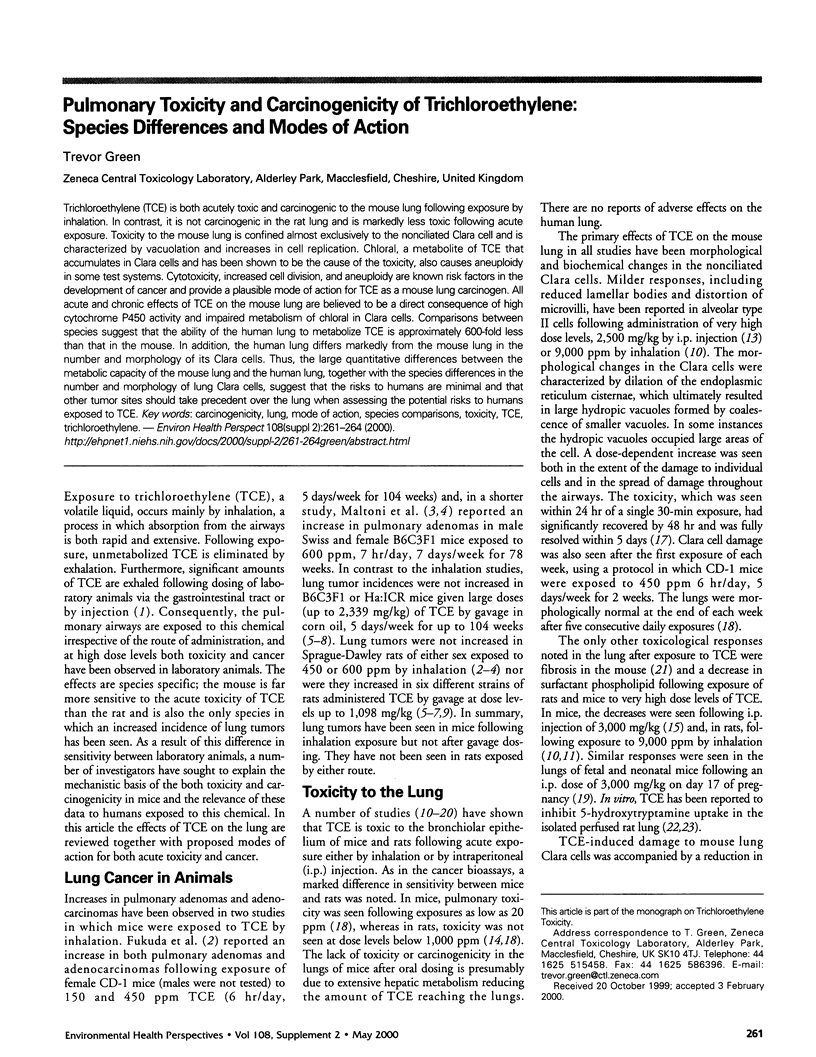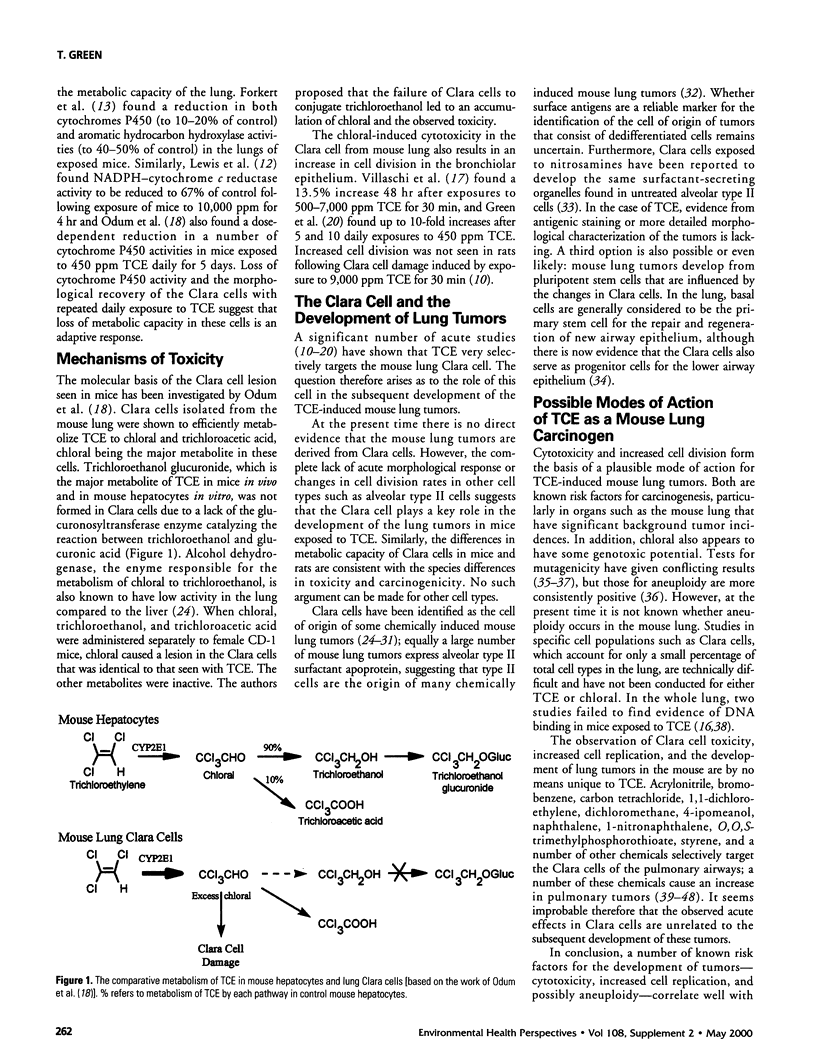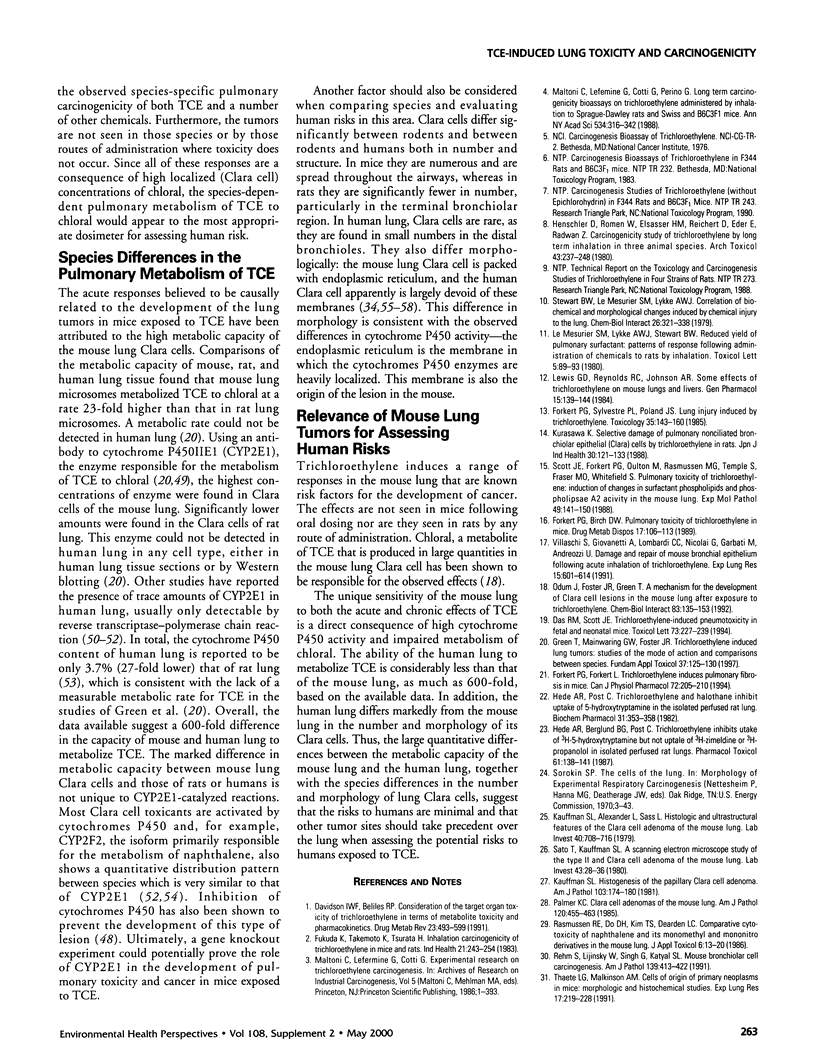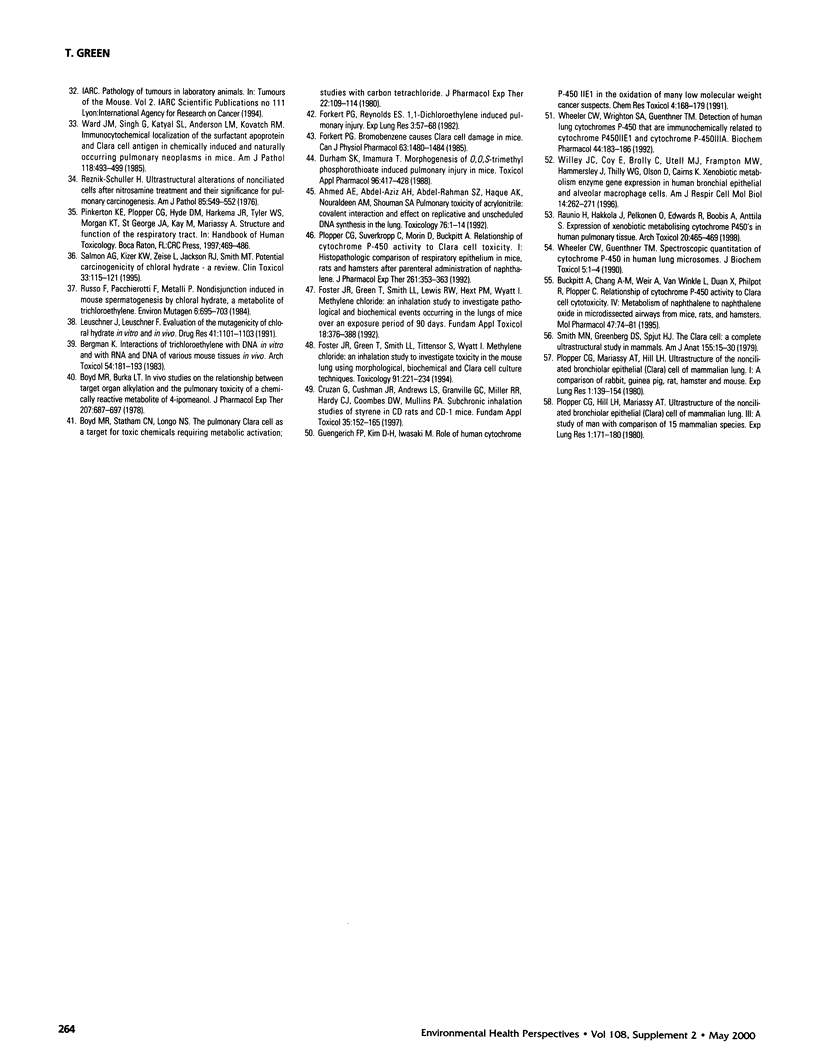Abstract
Trichloroethylene (TCE) is both acutely toxic and carcinogenic to the mouse lung following exposure by inhalation. In contrast, it is not carcinogenic in the rat lung and is markedly less toxic following acute exposure. Toxicity to the mouse lung is confined almost exclusively to the nonciliated Clara cell and is characterized by vacuolation and increases in cell replication. Chloral, a metabolite of TCE that accumulates in Clara cells and has been shown to be the cause of the toxicity, also causes aneuploidy in some test systems. Cytotoxicity, increased cell division, and aneuploidy are known risk factors in the development of cancer and provide a plausible mode of action for TCE as a mouse lung carcinogen. All acute and chronic effects of TCE on the mouse lung are believed to be a direct consequence of high cytochrome P450 activity and impaired metabolism of chloral in Clara cells. Comparisons between species suggest that the ability of the human lung to metabolize TCE is approximately 600-fold less than that in the mouse. In addition, the human lung differs markedly from the mouse lung in the number and morphology of its Clara cells. Thus, the large quantitative differences between the metabolic capacity of the mouse lung and the human lung, together with the species differences in the number and morphology of lung Clara cells, suggest that the risks to humans are minimal and that other tumor sites should take precedent over the lung when assessing the potential risks to humans exposed to TCE.
Full text
PDF



Selected References
These references are in PubMed. This may not be the complete list of references from this article.
- Ahmed A. E., Abdel-Aziz A. H., Abdel-Rahman S. Z., Haque A. K., Nouraldeen A. M., Shouman S. A. Pulmonary toxicity of acrylonitrile: covalent interaction and effect on replicative and unscheduled DNA synthesis in the lung. Toxicology. 1992 Nov 22;76(1):1–14. doi: 10.1016/0300-483x(92)90013-5. [DOI] [PubMed] [Google Scholar]
- Bergman K. Interactions of trichloroethylene with DNA in vitro and with RNA and DNA of various mouse tissues in vivo. Arch Toxicol. 1983 Nov;54(3):181–193. doi: 10.1007/BF01239202. [DOI] [PubMed] [Google Scholar]
- Boyd M. R., Burka L. T. In vivo studies on the relationship between target organ alkylation and the pulmonary toxicity of a chemically reactive metabolite of 4-ipomeanol. J Pharmacol Exp Ther. 1978 Dec;207(3):687–697. [PubMed] [Google Scholar]
- Boyd M. R., Statham C. N., Longo N. S. The pulmonary clara cell as a target for toxic chemicals requiring metabolic activation; studies with carbon tetrachloride. J Pharmacol Exp Ther. 1980 Jan;212(1):109–114. [PubMed] [Google Scholar]
- Buckpitt A., Chang A. M., Weir A., Van Winkle L., Duan X., Philpot R., Plopper C. Relationship of cytochrome P450 activity to Clara cell cytotoxicity. IV. Metabolism of naphthalene and naphthalene oxide in microdissected airways from mice, rats, and hamsters. Mol Pharmacol. 1995 Jan;47(1):74–81. [PubMed] [Google Scholar]
- Cruzan G., Cushman J. R., Andrews L. S., Granville G. C., Miller R. R., Hardy C. J., Coombs D. W., Mullins P. A. Subchronic inhalation studies of styrene in CD rats and CD-1 mice. Fundam Appl Toxicol. 1997 Feb;35(2):152–165. doi: 10.1006/faat.1996.2273. [DOI] [PubMed] [Google Scholar]
- Das R. M., Scott J. E. Trichloroethylene-induced pneumotoxicity in fetal and neonatal mice. Toxicol Lett. 1994 Sep;73(3):227–239. doi: 10.1016/0378-4274(94)90062-0. [DOI] [PubMed] [Google Scholar]
- Davidson I. W., Beliles R. P. Consideration of the target organ toxicity of trichloroethylene in terms of metabolite toxicity and pharmacokinetics. Drug Metab Rev. 1991;23(5-6):493–599. doi: 10.3109/03602539109029772. [DOI] [PubMed] [Google Scholar]
- Durham S. K., Imamura T. Morphogenesis of O,O,S-trimethyl phosphorothioate-induced pulmonary injury in mice. Toxicol Appl Pharmacol. 1988 Dec;96(3):417–428. doi: 10.1016/0041-008x(88)90002-6. [DOI] [PubMed] [Google Scholar]
- Forkert P. G., Birch D. W. Pulmonary toxicity of trichloroethylene in mice. Covalent binding and morphological manifestations. Drug Metab Dispos. 1989 Jan-Feb;17(1):106–113. [PubMed] [Google Scholar]
- Forkert P. G. Bromobenzene causes Clara cell damage in mice. Can J Physiol Pharmacol. 1985 Nov;63(11):1480–1484. doi: 10.1139/y85-244. [DOI] [PubMed] [Google Scholar]
- Forkert P. G., Forkert L. Trichloroethylene induces pulmonary fibrosis in mice. Can J Physiol Pharmacol. 1994 Mar;72(3):205–210. doi: 10.1139/y94-032. [DOI] [PubMed] [Google Scholar]
- Forkert P. G., Reynolds E. S. 1,1-Dichloroethylene-induced pulmonary injury. Exp Lung Res. 1982 Feb;3(1):57–68. doi: 10.3109/01902148209115816. [DOI] [PubMed] [Google Scholar]
- Forkert P. G., Sylvestre P. L., Poland J. S. Lung injury induced by trichloroethylene. Toxicology. 1985 May;35(2):143–160. doi: 10.1016/0300-483x(85)90028-9. [DOI] [PubMed] [Google Scholar]
- Foster J. R., Green T., Smith L. L., Lewis R. W., Hext P. M., Wyatt I. Methylene chloride--an inhalation study to investigate pathological and biochemical events occurring in the lungs of mice over an exposure period of 90 days. Fundam Appl Toxicol. 1992 Apr;18(3):376–388. doi: 10.1016/0272-0590(92)90136-6. [DOI] [PubMed] [Google Scholar]
- Foster J. R., Green T., Smith L. L., Tittensor S., Wyatt I. Methylene chloride: an inhalation study to investigate toxicity in the mouse lung using morphological, biochemical and Clara cell culture techniques. Toxicology. 1994 Aug 12;91(3):221–234. doi: 10.1016/0300-483x(94)90011-6. [DOI] [PubMed] [Google Scholar]
- Fukuda K., Takemoto K., Tsuruta H. Inhalation carcinogenicity of trichloroethylene in mice and rats. Ind Health. 1983;21(4):243–254. doi: 10.2486/indhealth.21.243. [DOI] [PubMed] [Google Scholar]
- Green T., Mainwaring G. W., Foster J. R. Trichloroethylene-induced mouse lung tumors: studies of the mode of action and comparisons between species. Fundam Appl Toxicol. 1997 Jun;37(2):125–130. doi: 10.1006/faat.1997.2312. [DOI] [PubMed] [Google Scholar]
- Guengerich F. P., Kim D. H., Iwasaki M. Role of human cytochrome P-450 IIE1 in the oxidation of many low molecular weight cancer suspects. Chem Res Toxicol. 1991 Mar-Apr;4(2):168–179. doi: 10.1021/tx00020a008. [DOI] [PubMed] [Google Scholar]
- Hede A. R., Berglund B. G., Post C. Trichloroethylene inhibits uptake of 3H-5-hydroxytryptamine but not uptake of 3H-zimeldine or 3H-propranolol in isolated perfused rat lungs. Pharmacol Toxicol. 1987 Aug;61(2):138–141. doi: 10.1111/j.1600-0773.1987.tb01791.x. [DOI] [PubMed] [Google Scholar]
- Hede A. R., Post C. Trichlorethylene and halothane inhibit uptake of 5-hydroxytryptamine in the isolated perfused rat lung. Biochem Pharmacol. 1982 Feb 1;31(3):353–358. doi: 10.1016/0006-2952(82)90182-4. [DOI] [PubMed] [Google Scholar]
- Henschler D., Romen W., Elsässer H. M., Reichert D., Eder E., Radwan Z. Carcinogenicity study of trichloroethylene by longterm inhalation in three animal species. Arch Toxicol. 1980 Feb;43(4):237–248. doi: 10.1007/BF00366179. [DOI] [PubMed] [Google Scholar]
- Jarabak R., Westley J. Competitive partial inhibitors of serum albumin-catalyzed sulfur cyanolysis. J Biochem Toxicol. 1990 Spring;5(1):1–8. doi: 10.1002/jbt.2570050102. [DOI] [PubMed] [Google Scholar]
- Kauffman S. L., Alexander L., Sass L. Histologic and ultrastructural features of the clara cell adenoma of the mouse lung. Lab Invest. 1979 Jun;40(6):708–716. [PubMed] [Google Scholar]
- Kauffman S. L. Histogenesis of the papillary Clara cell adenoma. Am J Pathol. 1981 May;103(2):174–180. [PMC free article] [PubMed] [Google Scholar]
- Kurasawa K. [Selective damage of pulmonary nonciliated bronchiolar epithelial (Clara) cells by trichloroethylene in rats]. Sangyo Igaku. 1988 Mar;30(2):121–133. doi: 10.1539/joh1959.30.121. [DOI] [PubMed] [Google Scholar]
- Le Mesurier S. M., Lykke A. W., Stewart B. W. Reduced yield of pulmonary surfactant: patterns of response following administration of chemicals to rats by inhalation. Toxicol Lett. 1980 Jan;5(1):89–93. doi: 10.1016/0378-4274(80)90153-8. [DOI] [PubMed] [Google Scholar]
- Leuschner J., Leuschner F. Evaluation of the mutagenicity of chloral hydrate in vitro and in vivo. Arzneimittelforschung. 1991 Oct;41(10):1101–1103. [PubMed] [Google Scholar]
- Lewis G. D., Reynolds R. C., Johnson A. R. Some effects of trichloroethylene on mouse lungs and livers. Gen Pharmacol. 1984;15(2):139–144. doi: 10.1016/0306-3623(84)90096-x. [DOI] [PubMed] [Google Scholar]
- Maltoni C., Lefemine G., Cotti G., Perino G. Long-term carcinogenicity bioassays on trichloroethylene administered by inhalation to Sprague-Dawley rats and Swiss and B6C3F1 mice. Ann N Y Acad Sci. 1988;534:316–342. doi: 10.1111/j.1749-6632.1988.tb30120.x. [DOI] [PubMed] [Google Scholar]
- Odum J., Foster J. R., Green T. A mechanism for the development of Clara cell lesions in the mouse lung after exposure to trichloroethylene. Chem Biol Interact. 1992 Aug 14;83(2):135–153. doi: 10.1016/0009-2797(92)90042-j. [DOI] [PubMed] [Google Scholar]
- Palmer K. C. Clara cell adenomas of the mouse lung. Interaction with alveolar type 2 cells. Am J Pathol. 1985 Sep;120(3):455–463. [PMC free article] [PubMed] [Google Scholar]
- Plopper C. G., Hill L. H., Mariassy A. T. Ultrastructure of the nonciliated bronchiolar epithelial (Clara) cell of mammalian lung. III. A study of man with comparison of 15 mammalian species. Exp Lung Res. 1980 Jun;1(2):171–180. doi: 10.3109/01902148009069646. [DOI] [PubMed] [Google Scholar]
- Plopper C. G., Mariassy A. T., Hill L. H. Ultrastructure of the nonciliated bronchiolar epithelial (Clara) cell of mammalian lung: I. A comparison of rabbit, guinea pig, rat, hamster, and mouse. Exp Lung Res. 1980 Jun;1(2):139–154. doi: 10.3109/01902148009069644. [DOI] [PubMed] [Google Scholar]
- Plopper C. G., Suverkropp C., Morin D., Nishio S., Buckpitt A. Relationship of cytochrome P-450 activity to Clara cell cytotoxicity. I. Histopathologic comparison of the respiratory tract of mice, rats and hamsters after parenteral administration of naphthalene. J Pharmacol Exp Ther. 1992 Apr;261(1):353–363. [PubMed] [Google Scholar]
- Rasmussen R. E., Do D. H., Kim T. S., Dearden L. C. Comparative cytotoxicity of naphthalene and its monomethyl- and mononitro-derivatives in the mouse lung. J Appl Toxicol. 1986 Feb;6(1):13–20. doi: 10.1002/jat.2550060104. [DOI] [PubMed] [Google Scholar]
- Raunio H., Hakkola J., Hukkanen J., Pelkonen O., Edwards R., Boobis A., Anttila S. Expression of xenobiotic-metabolizing cytochrome P450s in human pulmonary tissues. Arch Toxicol Suppl. 1998;20:465–469. doi: 10.1007/978-3-642-46856-8_41. [DOI] [PubMed] [Google Scholar]
- Rehm S., Lijinsky W., Singh G., Katyal S. L. Mouse bronchiolar cell carcinogenesis. Histologic characterization and expression of Clara cell antigen in lesions induced by N-nitrosobis-(2-chloroethyl) ureas. Am J Pathol. 1991 Aug;139(2):413–422. [PMC free article] [PubMed] [Google Scholar]
- Reznik-Schüller H. Ultrastructural alterations of nonciliated cells after nitrosamine treatment and their significance for pulmonary carcinogenesis. Am J Pathol. 1976 Dec;85(3):549–554. [PMC free article] [PubMed] [Google Scholar]
- Russo A., Pacchierotti F., Metalli P. Nondisjunction induced in mouse spermatogenesis by chloral hydrate, a metabolite of trichloroethylene. Environ Mutagen. 1984;6(5):695–703. doi: 10.1002/em.2860060507. [DOI] [PubMed] [Google Scholar]
- Salmon A. G., Kizer K. W., Zeise L., Jackson R. J., Smith M. T. Potential carcinogenicity of chloral hydrate--a review. J Toxicol Clin Toxicol. 1995;33(2):115–121. doi: 10.3109/15563659509000460. [DOI] [PubMed] [Google Scholar]
- Sato T., Kauffman S. L. A scanning electron microscopic study of the Type II and Clara cell adenoma of the mouse lung. Lab Invest. 1980 Jul;43(1):28–36. [PubMed] [Google Scholar]
- Scott J. E., Forkert P. G., Oulton M., Rasmusson M. G., Temple S., Fraser M. O., Whitefield S. Pulmonary toxicity of trichloroethylene: induction of changes in surfactant phospholipids and phospholipase A2 activity in the mouse lung. Exp Mol Pathol. 1988 Aug;49(1):141–150. doi: 10.1016/0014-4800(88)90028-7. [DOI] [PubMed] [Google Scholar]
- Smith M. N., Greenberg S. D., Spjut H. J. The Clara cell: a comparative ultrastructural study in mammals. Am J Anat. 1979 May;155(1):15–30. doi: 10.1002/aja.1001550103. [DOI] [PubMed] [Google Scholar]
- Stewart B. W., Le Mesurier S. M., Lykke A. W. Correlation of biochemical and morphological changes induced by chemical injury to the lung. Chem Biol Interact. 1979 Aug;26(3):321–338. doi: 10.1016/0009-2797(79)90035-8. [DOI] [PubMed] [Google Scholar]
- Thaete L. G., Malkinson A. M. Cells of origin of primary pulmonary neoplasms in mice: morphologic and histochemical studies. Exp Lung Res. 1991 Mar-Apr;17(2):219–228. doi: 10.3109/01902149109064413. [DOI] [PubMed] [Google Scholar]
- Villaschi S., Giovanetti A., Lombardi C. C., Nicolai G., Garbati M., Andreozzi U. Damage and repair of mouse bronchial epithelium following acute inhalation of trichloroethylene. Exp Lung Res. 1991 May-Jun;17(3):601–614. doi: 10.3109/01902149109062868. [DOI] [PubMed] [Google Scholar]
- Ward J. M., Singh G., Katyal S. L., Anderson L. M., Kovatch R. M. Immunocytochemical localization of the surfactant apoprotein and Clara cell antigen in chemically induced and naturally occurring pulmonary neoplasms of mice. Am J Pathol. 1985 Mar;118(3):493–499. [PMC free article] [PubMed] [Google Scholar]
- Wheeler C. W., Wrighton S. A., Guenthner T. M. Detection of human lung cytochromes P450 that are immunochemically related to cytochrome P450IIE1 and cytochrome P450IIIA. Biochem Pharmacol. 1992 Jul 7;44(1):183–187. doi: 10.1016/0006-2952(92)90055-n. [DOI] [PubMed] [Google Scholar]
- Willey J. C., Coy E., Brolly C., Utell M. J., Frampton M. W., Hammersley J., Thilly W. G., Olson D., Cairns K. Xenobiotic metabolism enzyme gene expression in human bronchial epithelial and alveolar macrophage cells. Am J Respir Cell Mol Biol. 1996 Mar;14(3):262–271. doi: 10.1165/ajrcmb.14.3.8845177. [DOI] [PubMed] [Google Scholar]


